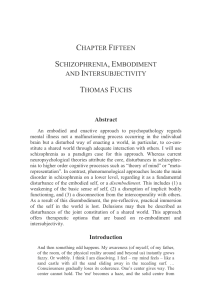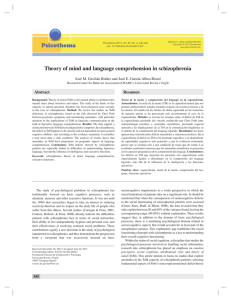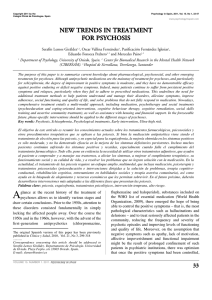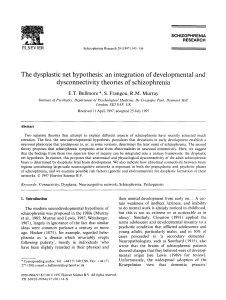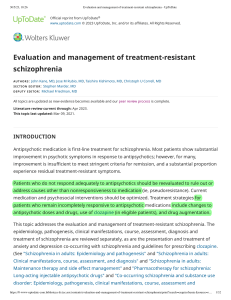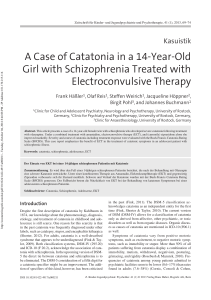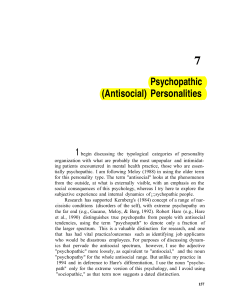It is well known that patients with schizophrenia suffer present with a
Anuncio
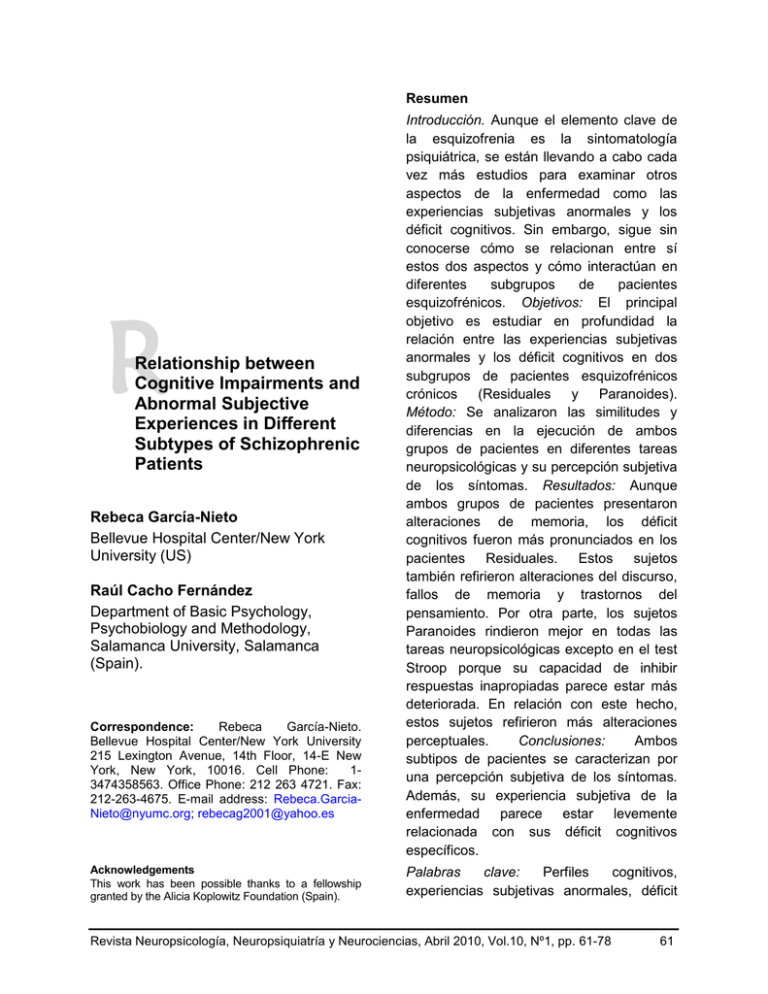
Resumen R Relationship between Cognitive Impairments and Abnormal Subjective Experiences in Different Subtypes of Schizophrenic Patients Rebeca García-Nieto Bellevue Hospital Center/New York University (US) Raúl Cacho Fernández Department of Basic Psychology, Psychobiology and Methodology, Salamanca University, Salamanca (Spain). Correspondence: Rebeca García-Nieto. Bellevue Hospital Center/New York University 215 Lexington Avenue, 14th Floor, 14-E New York, New York, 10016. Cell Phone: 13474358563. Office Phone: 212 263 4721. Fax: 212-263-4675. E-mail address: Rebeca.GarciaNieto@nyumc.org; rebecag2001@yahoo.es Acknowledgements This work has been possible thanks to a fellowship granted by the Alicia Koplowitz Foundation (Spain). Introducción. Aunque el elemento clave de la esquizofrenia es la sintomatología psiquiátrica, se están llevando a cabo cada vez más estudios para examinar otros aspectos de la enfermedad como las experiencias subjetivas anormales y los déficit cognitivos. Sin embargo, sigue sin conocerse cómo se relacionan entre sí estos dos aspectos y cómo interactúan en diferentes subgrupos de pacientes esquizofrénicos. Objetivos: El principal objetivo es estudiar en profundidad la relación entre las experiencias subjetivas anormales y los déficit cognitivos en dos subgrupos de pacientes esquizofrénicos crónicos (Residuales y Paranoides). Método: Se analizaron las similitudes y diferencias en la ejecución de ambos grupos de pacientes en diferentes tareas neuropsicológicas y su percepción subjetiva de los síntomas. Resultados: Aunque ambos grupos de pacientes presentaron alteraciones de memoria, los déficit cognitivos fueron más pronunciados en los pacientes Residuales. Estos sujetos también refirieron alteraciones del discurso, fallos de memoria y trastornos del pensamiento. Por otra parte, los sujetos Paranoides rindieron mejor en todas las tareas neuropsicológicas excepto en el test Stroop porque su capacidad de inhibir respuestas inapropiadas parece estar más deteriorada. En relación con este hecho, estos sujetos refirieron más alteraciones perceptuales. Conclusiones: Ambos subtipos de pacientes se caracterizan por una percepción subjetiva de los síntomas. Además, su experiencia subjetiva de la enfermedad parece estar levemente relacionada con sus déficit cognitivos específicos. Palabras clave: Perfiles cognitivos, experiencias subjetivas anormales, déficit Revista Neuropsicología, Neuropsiquiatría y Neurociencias, Abril 2010, Vol.10, Nº1, pp. 61-78 61 García-Nieto & Cacho cognitivos, esquizofrenia crónica, subtipos residuales y paranoides. Key words: Cognitive profiles, abnormal subjective experiences, cognitive impairments, chronic schizophrenic patients, residual and paranoid subtypes. Summary Introduction. Although the defining element of schizophrenia is psychiatric symptomatology, more and more studies are being conducted to study other aspects such as abnormal subjective experiences and cognitive deficits. Nonetheless, it remains unknown how these two latter aspects affect each other throughout the illness and how they interact in different subgroups of schizophrenic patients. Aims. The primary goal is to study in depth the relationship between abnormal subjective experiences and cognitive deficits in two subgroups of chronic schizophrenic outpatients (Residual and Paranoid subjects). Method. Similarities and differences in the performance of both groups of patients in different neuropsychological tasks and their subjective perception of the symptoms were analyzed. Results. Although both groups of patients presented with memory impairments, cognitive deficits were more prominent in Residual patients. These subjects also complained about speech disturbances, memory failures and thought disorders. On the other hand, Paranoid subjects performed better in all the neuropsychological tasks except for the Stroop test because their ability to inhibit inappropriate responses seems to be more impaired. In close relation to this, these subjects complained more about perceptual disturbances. Conclusions. Both subtypes of patients are characterised by a distinctive subjective perception of symptoms. Besides, their subjective experience of the illness seems to be mildly related to their specific cognitive deficits. 62 Introduction It has been pointed out that contemporary psychopathology downplays anomalies of the patient’s subjectivity and that this neglect may have deleterious consequences for research in the causes and the boundaries of the schizophrenia spectrum conditions (Parnas, Handest, Saebye, & Jansson, 2003). Although the key defining element of schizophrenia is still psychiatric symptomatology, it is noteworthy that more and more attention is being paid to other elements of the psychopathological spectrum. For instance, abnormal subjective experiences are becoming accepted as having important implications for the comprehension and treatment of schizophrenic disorders (Barnes & Phillips, 1995). As a result of the acknowledgement of this neglect, a recent trend in research that focuses on the subjective complaints of schizophrenic patients has. In this respect, several studies have been carried out so as to explore the relationships between these self-experienced cognitive disturbances and objective symptoms in schizophrenia. Some studies, such as that of Yon, Loas, and Brien (2005), have not found any relationships between these two aspects; whilst others, such as that of Hummeler, Stohr, and Jahn (2005) have found a significant correlation between abnormal subjective experiences and positive symptoms. These contradictory findings show that, although subjectively Revista Neuropsicología, Neuropsiquiatría y Neurociencias Cognitive Impairments and Abnormal Subjective Experiences in Schizophrenia experienced deficits may improve the understanding and treatment of schizophrenia, our knowledge of these deficits is still fragmentary. In spite of the apparent novelty of this field, it was Huber (1966) who initiated this line of research in the sixties. According to this author and his colleagues, Basic Symptoms are subclinical self-experienced disturbances phenomenologically clearly distinct from attenuated or frank psychotic symptoms (Gross, Huber, Klosterkötter, & Linz, 1987). Since both Basic Symptoms and cognitive deficiencies can appear long time before the outbreak of schizophrenia (Schultze-Lutter, Ruhrmann, Hoyer, Klosterkötter, & Leweke, 2007; Simon et al., 2006), Huber came to the conclusion that Basic Symptoms represent the conscious experience of several cognitive deficiencies and that they both may originate from a common psychopathological matrix (Bove, 2005). Unfortunately, over 40 years later, it can be stated that literature on how these two aspects relate to each other is scarce and contradictory. Several studies conducted to address this issue (Böker et al., 1984; Brenner, Böker, Müller, Spichtig, & Würgler, 1987; Williams, Alagaratnam, & Hemsley, 1984; Zanello & Huguelet, 2001) did not find any relationship between cognitive impairments and subjective disturbances, whilst others (Cuesta, Peralta, & Juan, 1996; Pazzagli & Pallanti, 1991; Van der Bosch & Rozendaal, 1988; Hartwich, 1980) did find significant associations between them. Taking into account this situation, we consider that studies conducted to shed light on this issue are still necessary. On the other hand, it is well established that both self-experienced disturbances and cognitive deficits can appear months or years prior to psychotic decompensation, therefore these experiential anomalies appear to be relevant for early differential diagnosis and potentially useful in the preonset detection of the schizophrenia spectrum illness (Parnas et al., 2003). Nevertheless, it remains unknown how these two aspects affect each other over the course of the illness. It is known that these abnormal subjective experiences are present in non-active periods of the illness (e.g. post-psychotic episodes). In fact they have been described as the more lasting schizophrenic symptoms, responsible for the prodromal and residual phases of the illness (Gross, 1972). Cognitive deficits, for its part, appear relatively stable over time (Friedman et al., 2001; Harvey, Docherty, Serper, & Rasmussen, 1990) and remain in spite of the remission of psychotic symptoms (Heaton et al., 2001). Since we still do not know how these two factors interact in different subgroups of schizophrenic patients, we carried out this exploratory study so as to deepen our knowledge on the relationships between abnormal subjective experiences and cognitive deficits in two subgroups of chronic schizophrenic outpatients. We studied a sample of patients diagnosed with Residual Schizophrenia as a model of greater negative symptoms and a sample of patients diagnosed with Paranoid Schizophrenia as a model of greater positive symptoms. To the best of our knowledge, no other study has been conducted to address this issue, therefore being this an exploratory study we acknowledge several limitations that will be described in detail in the discussion. Revista Neuropsicología, Neuropsiquiatría y Neurociencias 63 García-Nieto & Cacho Methods Subjects Due to the exploratory nature of our work, a small sample of patients with a specific profile was recruited. 24 patients who met DSM-IV-TR criteria for Paranoid (N=12) or Residual (N=12) schizophrenia were selected from the database of outpatients of the “Dr. Villacián” Mental Hospital in Valladolid (Spain). The diagnoses had been made by several senior psychiatrists by using all the information available from clinical observations, medical records and key informants. The subjects had been diagnosed between 6 and 8 years before and they all were receiving a similar kind of treatment (most of them were being treated with Risperidone and Olanzapine). The subjects, aged 30-60 years, were outpatients pharmacologically and psychiatrically stable for at least 6 months. During this period, diagnostic stability was confirmed at subsequent assessments (monthly routine clinical interviews carried out by senior psychiatrists using the DSM-IV diagnostic criteria for schizophrenia). Exclusion criteria included history of substance abuse, severe head injury, organic brain syndrome, mental retardation and any other mental illness or medical condition. The mean age of the patients was 44.25 (SD= 5.61). 58.33% of subjects were men and 41.67% were women. Most of them lived with their families, 2 lived with their parents and 2 lived on their own. Regarding their education level, it is worth noting that 18 patients got primary education degrees, 2 got secondary education degrees and 4 had received vocational training. With respect to their labour situation, 21 subjects were receiving a pension for disability and 3 women were working as housewives. Socio-demographic characteristics of subjects are depicted in Table 1. All subjects participated in the study after signing a written voluntary informed consent form. Table 1 Socio-demographic features Residual Subjects Paranoid Subjects Variables N % N % Sex Female 4 33.3 6 50.0 Male 8 66.6 6 50.0 Mean SD Mean Age (Years) 46.7 4.9 Age of onset 39.7 Evolution (Years) Education (Years) Number of outbreaks Statistics 2 X df p 0.667 1 .414 SD T df p 42.9 5.3 1.836 22 .080 4.9 35.5 5.2 2.027 22 .055 7.1 0.9 7.2 0.7 -0.251 22 .804 8 1.2 9.4 1.7 -2.327 22 .030 1.4 0.5 2.9 0.7 -5.496 22 .000** ** p<0.001 64 Revista Neuropsicología, Neuropsiquiatría y Neurociencias Cognitive impairments and abnormal subjective experiences in schizophrenia Study instruments Psychopathological assessment All patients were evaluated with the Frankfurt Psychopathological Inventory (FBF-III) translated and validated in Spain (Jimeno, Jimeno, & Vargas, 1996). We used percentile scores. The Frankfurt Psychopathological Inventory (FBF-III) has been widely used both in the clinical and in the research field. The main clinical indication of FBF-III is the quantification of vulnerability to schizophrenia. Besides, it allows the clinician to outline a subjective cognitive profile for each patient, being this essential to carry out a tailored treatment for each patient. In the research field, it has been mostly used within the framework of the Basic Symptoms Theory (Huber, 1983). In Spain, the Frankfurt Psychopathological Inventory (FBF-III) has also been used in the area of neurocognitive rehabilitation (Vargas, 2004). Briefly, FBF-III consists of 10 subscales: 1) Loss of Control (LC): The psychotic patient may experience that their thoughts, feelings and behaviours are beyond their control. 2) Simple Perception (SP): The most typical change in the sensory experience is familiarity loss with their perceptions. If the sensation of unreality concerns oneself or parts of oneself is called “depersonalization” and if it concerns one´s environment is known as “derealization”. 3) Complex Perception (CP): This subscale assesses misperceptions, difficulties in discerning perception and representation and uncertainties when making sense of the scene as a whole or fragments of it. 4) Speech (S): It evaluates perseverative language, diminishment of vocabulary, derailments (gradual or sudden deviation of the train of thought without blocking), among others. 5) Cognition and Thought (CT): It assesses any disturbance of thinking that affects language, communication or thought content. Manifestations range from simple blocking and mild circumstantiality to profound loosening of associations, incoherence, and delusions. 6) Memory (ME): This subscale comprises typical complaints made by schizophrenic patients regarding memory. Some items of this subscale are: “Many things that I knew have vanished”; “My memory is not working properly, I notice memory failures”, “When I read a long sentence I nearly always forget the beginning”, among others. 7) Motor Behaviour (MO): It assesses difficulties in psychomotor organization, articulation of words and propioceptive notion of one´s movement. Some items are: “Sometimes I cannot speak properly although I have in mind the words I want to say”, “Sometimes I have to stop in the middle of a movement in order to think how to continue”. 8) Loss of Automatisms (LA): Our daily live activities depend on the right functioning of a lot of skills that are performed automatically. Some schizophrenic patients notice that they have to pay attention to each step involved in ordinary activities such as: walking, eating or talking. This subscale assesses this kind of deficits. Some items are: “I find the activities of daily living more difficult than they used to be, I have to think carefully about the steps of each one before doing them” or “When walking, I have to be aware of each and every step I take”. 9) Anhedonia and anxiety (AA): Schizophrenic patients are sometimes unable to distinguish among their emotions Revista Neuropsicología, Neuropsiquiatría y Neurociencias 65 García-Nieto & Cacho because most of them become unpleasant and confusing. 10) Irritability due to stimuli overload (I): Some apparently bizarre behaviours characteristic of psychotic patients stem from their attempts to protect themselves from overstimulation. Some items of this subscale are: “Sometimes it seems to me that everything passes me by as if in a film. It is as though my eyes could not retain anything”; “I feel too awake and I have to pay attention to everything even though I do not want to” or “I cannot think and notice all that is happening around me at the same time, I have to focus on one thing or the other”. and validated in Spain (Wechsler, 1999). We used scalar scores. Neuropsychological assessment Neuropsychological tests were assessed by a clinical psychologist who was not aware of the classification of the subjects. The tests used in this study were administered and scored according to standard instructions in the same way for all subjects. They were administered in three sessions during the week after the psychopathological assessment. No subject was familiar with the tests. The Stroop Test It has been widely used to assess attention/executive functioning. It evaluates selective attention and shifting ability (considered as an executive function). In this study, the Colour-Word and the Interference Score are of great interest. These two scores indicate whether the ability of the subject to inhibit non-relevant stimuli is impaired or not. We used the Spanish version of the test (Golden, 2001). In order to analyze the data we used Tscores. Statistical analysis Statistical analysis of the results was carried out using SPSS 15.0 for Windows (SPSS Inc., USA). Socio-demographic characteristics, except for Sex which was analyzed with the Chi-Square test, were analysed using the T-test for independent samples. Since many of the remaining variables did not meet normality criteria, they were analyzed using non-parametric methods, particularly the Kruskal-Wallis H test. When statistically significant differences were found, the Mann-Whitney U test was applied in order to find out which The Wechsler Adult Intelligence Scale-III (WAIS-III) This scale is used as a measure for global cognitive functioning (Full Scale IQ). Besides, it allows the examiner to outline a profile of the cognitive functioning of each subject, both in verbal tasks and non-verbal tasks. Many studies have made use of different subtests of the WAIS in order to assess cognitive disorders in schizophrenic patients. For instance, Freeland and Puente (1984) conducted a study which proved the efficacy of the WAIS in discriminating schizophrenics with and without brain damage. We used the version translated 66 The Wechsler Memory Scale (WMS) It has been used in the study of memory dysfunction in schizophrenia (Toulopoulou, Rabe-Hesketh, King, Murray, & Morris, 2003). The tasks that we selected from the WMS were: Mental Control (to evaluate attention/executive function), Logic Memory (to assess verbal memory), Visual Retention (to explore visual memory) and Verbal Paired Associates (to evaluate verbal learning ability). We used the version translated and validated in Spain (Wechsler, 2004). We used scalar scores. Revista Neuropsicología, Neuropsiquiatría y Neurociencias Cognitive Impairments and Abnormal Subjective Experiences in Schizophrenia Results groups attained statistical significance. In order to diminish the type I error as far as possible we used a more conservative Pvalue. In this way, we only considered Pvalues less than 0.01 as significant. Besides, P-values were two-tailed. Psychopathological assessment Table 2 depicts the scores obtained by the two groups of patients in the FBF-III. No differences between both groups were found for the following variables: Motor Bahaviour-MO- (U=47.0; p=0.070), Loss of Automatisms –LA- (U=56.5; p=0.292) and Anhedonia and anxiety –AA- (U=59.5; p=0.433). Residual subjects scored significantly higher in the following variables: Cognition and Thought –CT(U=0.0; p<0.001), Speech –S- (U=0.0; p<0.001) and Memory –ME- (U=0.0; p<0.001); whereas Paranoid subjects obtained significantly higher scores in: Loss of Control –LC- (U=0.0; p<0.001), Simple Perception –SP- (U=4.0; p<0.001), Complex Perception –CP- (U=26.0; p<0.01) and Irritability due to stimuli overload –I- (U=0.0; p<0.001). With regard to the analysis of the relationships between psycho-pathological and cognitive variables, we used the Spearman correlation coefficient. Partial correlation analyses were performed to control for the influence of Education and Number of outbreaks because they might affect neuropsychological performance. Due to the great amount of variables involved in the correlation analysis, the comparison procedure was appropriately adjusted by reducing the level of significance (Bonferroni procedure). All P-values were two-tailed and considered as significant when corrected probabilities were less than .001. Table 2 Mean and Standard Deviation scores in the Frankfurt Psychopathological Inventory (FBF-III) FBF-III Residual Subjects Statistics Paranoid Subjects H 2 U Mean SD Mean SD X df p p LC 69.5 6.6 91.9 4.2 18.189 1 .000 .000 ** SP 94.6 1.7 98.1 0.5 16.714 1 .000 .000 ** CP 95.2 2.7 97.8 1.0 8.423 1 .004 .004 * S 90.6 1.9 81.9 4.0 20.012 1 .000 .000 ** CT 89.9 4.4 70.8 3.8 18.400 1 .000 .000 ** ME 97.5 2.1 80.5 3.3 18.607 1 .000 .000 ** MO 98.7 1.2 98.3 0.9 3.273 1 .070 .070 LA 96.3 1.9 95.5 1.7 1.112 1 .292 .292 AA 92.1 3.1 93.0 3.6 0.615 1 .433 .433 I 81.2 3.2 94.4 2.8 18.451 1 .000 .000 ** LC: Loss of Control, SP: Simple Perception, CP: Complex Perception, S: Speech, CT: Cognition and Thought, ME: Memory, MO: Motor Behaviour, LA: Loss of Automatisms, AA: Anhedonia and anxiety, I: Irritability due to stimuli overload. * p<0.01, ** p<0.001 Revista Neuropsicología, Neuropsiquiatría y Neurociencias 67 García-Nieto & Cacho Cognitive assessment Mean scores of subjects in different subtests of the WAIS are depicted in Table 3. Subjects diagnosed with Paranoid Schizophrenia scored significantly higher in all the Verbal Scale subtests: Vocabulary (U=0.0; p<0.001), Similarities (U=0.0; p<0.001), Information (U=0.0; p<0.001), Comprehension (U=0.0; p<0.001), Aritmethic (U=0.0; p<0,001) and Digit Span (U=1.0; p<0.001). On the other hand, there were no differences between the two groups in any of the Performance subscales of the WAIS: Picture Arrangement (U=46.0; p=0.115, Picture Completion (U=63.5; p=0.611), Block Design (U=62.0; p=0.544), Matrix Reasoning (U=54.5; p=0.287), DigitSymbol Coding (U=66.5; p=0.739) and Symbol Search (U=50.0; p=0.183). Table 3 Mean and Standard Deviation scores in the WAIS-III WAIS-III Residual Paranoid Subjects Subjects Statistics H 2 U Mean SD Mean SD X df p p Vocabulary 7.0 0.4 11.4 1.2 18.800 1 .000 .000 ** Similarities 5.8 1.2 11.8 0.8 18.016 1 .000 .000 ** Arithmetic 2.9 0.3 7.0 1.0 19.454 1 .000 .000 ** Digit Span 3.4 0.8 6.3 0.9 17.401 1 .000 .000 ** Information 6.3 1.2 12.9 1.2 17.672 1 .000 .000 ** Comprehension 8.3 1.1 13.4 0.9 17.711 1 .000 .000 ** Picture Completion 4.0 1.3 4.2 1.2 0.258 1 .611 .611 Symbol Search 3.8 1.1 4.3 0.8 1.770 1 .183 .183 Digit- Symbol Coding 5.1 1.2 5.2 1.0 0.111 1 .739 .739 Block Design 3.5 1.3 3.8 0.9 0.369 1 .544 .544 Matrix Reasoning 3.7 1.0 4.2 0.9 1.135 1 .287 .287 Picture Arrangement. 5.8 1.0 6.5 1.0 2.479 1 .115 .115 ** p<0.001 With regard to the Stroop Test, the scores are presented in Table 4. The statistical analysis yielded that Residual subjects scored significantly higher than Paranoid ones in Colour-Word (U=0.0; p<0.001) and Interference (U=0.0; p<0.001). Finally, the analysis of the scores obtained in the Wechsler Memory Scale depicted in 68 Table 4) shows that Paranoid subjects scored significantly higher in Logic Memory (U=0.0; p<0.001) and in Verbal Paired Associates (U=0.0; p<0,001). The differences between the two groups in Mental Control (U=41.0; p=0.055) and Visual Retention (U=67.0; p=0.684) were not significant. Revista Neuropsicología, Neuropsiquiatría y Neurociencias Cognitive Impairments and Abnormal Subjective Experiences in Schizophrenia Table 4 Mean and Standard Deviation scores in the Stroop Test and the Wechsler Memory Scale (WMS) Residual Paranoid Subjects Subjects Mean SD Mean SD Statistics H 2 U X df p p Stroop Test Color Word Interference 39.6 -7.3 0.5 0.8 36.7 -10.7 0.6 1.1 18.324 17.783 1 1 .000** .000** .000** .000** Wechsler Memory Scale Mental Control Logical Memory Visual Retention Verbal Paired Associates 6.4 10.9 6.9 10.4 0.8 0.5 0.3 0.5 7.0 18.0 7.0 14.2 0.6 0.4 0.6 1.1 3.825 19.734 .166 18.049 1 1 1 1 .050 .000** .684 .000** .050 .000** .684 .000** ** p<0.001 Relationship between abnormal subjective experiences and neuropsychological performance Correlations among patients´ subjective complaints (assessed by the FBF-III) and their performance in neuropsychological tasks are depicted in Table 5. Information (InF). We also found that Memory (ME) correlated with Vocabulary (V), Similarities (SiM) and Aritmethic (A) in a significant way. However, no significant correlations were found between the performance in the Performance Subscales of the WAIS-III and the FBF-III scores. We have found significant positive correlations between Loss of Control (LC) and the following subscales of the WAIS-III: Vocabulary (V), Similarities (SiM), Aritmethic (A) and Digit-Span (D). We also found significant positive correlations between Simple Perception (SP) and Vocabulary (V), and between Irritability due to stimuli overload (I) and the following subscales of the WAIS-III: Vocabulary (V) and Aritmethic (A). On the other hand, we found significant negative correlations between Speech (S) and the following subscales of the WAIS-III: Vocabulary (V), Aritmethic (A) and Comprehension (C), and between Cognition and thought (CT) and the following subscales of the WAIS-III: Similarities (SiM), Aritmethic (A) and Correlation analyses between the Stroop Test and the FBF-III subscales yielded significant positive correlations between the Stroop Color-Word and Memory (ME) and between Interference, Memory (ME) and Speech (S). Finally, correlation analyses between the scores obtained in the Wechsler Memory scale (WMS) and in the FBF-III showed that there were no significant correlations between Visual Retention (VR), Mental Control (MC), Verbal Paired Associates (VP) and the FBF-III subscales. Nonetheless, we found significant positive correlations between their performance in Logical Memory (LM) and Lost of Control (LC), Simple Perception (SP) and Irritability due to stimuli overload (I). Besides, we have Revista Neuropsicología, Neuropsiquiatría y Neurociencias 69 García-Nieto & Cacho found significant negative correlations between the scores obtained by patients in Logical Memory (LM) and Speech (S), Cognition and thought (CT) and Memory (ME). Nonetheless, it is noteworthy that when we conducted the correlation analyses separately for each group we only found significant positive correlations between Vocabulary (V) and Motor Behaviour (MO) (r= 0.895, p<0.001) and between Visual Retention (VR) and Motor Behaviour (MO) (r= 0.980, p< 0.001) and a significant negative correlation between Mental Control (MC) and Cognition and thought (CT) (r= 0.858, p< 0.001) in the Residual group, not finding any significant correlations between the scores obtained by Paranoid subjects in cognitive tasks and the psychopathological scales (FBF-III). Discussion Despite the fact that most schizophrenic patients present with some cognitive deficits, different studies have pointed out the existence of a group of schizophrenic patients with mild deficits or a cognitive functioning close to normality (Goldstein, 1994; Goldstein, Allen, & Seaton, 1998; Goldstein & Shemansky, 1995; Heinrichs & Awad, 1993; Seaton, Allen, Goldstein, Kelley, & Van Kammen, 1999). As we stated previously, comparisons between Paranoid and Residual subgroups indicate that paranoid patients tend to be more cognitively intact than residual ones. These data are consistent with other research studies which point out that cognitive functions of paranoid patients are mostly preserved (Bornstein et al., 1990; Brazoa et al., 2002; Goldstein, Shemansky, & Allen, 2005; Seltzer, Conrad, & Cassens, 1997). 70 In addition to this, our study yields some results that should be noted. Firstly, our findings reveal that Residual patients perform far below normal in verbal subscales of the WAIS-III, whereas scores of Paranoid subjects in these tasks fall within the normal range. It is also noteworthy that the lowest scores obtained by Paranoid subjects in verbal subscales are in the Digit Span (D) and Arithmetic (A) tasks. These subtests might be assessing working memory, at least partly. This cognitive function might be differently impaired in schizophrenic subjects. Besides, it has been suggested that a dysfunction in the working memory domain is a potential endophenotype candidate for schizophrenia (Peuskens, Demily, & Thibaut, 2005). Secondly, we have not found significant differences between the two groups of patients in the Performance subscales of the WAIS-III. Nevertheless, both of them are far below the expected values in normal subjects, which suggest an important impairment. On the whole, the performance of a given subject in the Performance tasks of the WAIS-III is influenced by time. Among other functions, these tasks assess processing speed and it is known that, in general, schizophrenic patients are slower when processing stimuli. Besides, those tasks in which speed plays a major role are very sensitive to extrapyramidal symptoms induced by some neuroleptics. Our sample is formed mostly by patients who are receiving treatment with new-generation antipsychotics that produce less extrapyramidal symptoms; thus, it is not very likely that these low scores could be attributed to medication. Other research studies such as that of Seaton et al. (1999), in which the different scales of the WAIS-III Revista Neuropsicología, Neuropsiquiatría y Neurociencias Cognitive Impairments and Abnormal Subjective Experiences in Schizophrenia were used to study cognitive subtypes, also found group of subjects who performed well in verbal scales in contrast to their poor performance in some of the performance scales of the WAIS-III. Our findings seem to be consistent with these studies. Thirdly, the fact that Paranoid subjects perform worse in the Stroop Test seems to indicate a lower ability of these patients to focus their attention and inhibit inappropriate responses. Although there are studies in which an impaired performance of paranoid subjects in the Stroop test has not been found (Brazoa et al, 2002) our data are in accordance with the hypothesis that patients suffering from positive symptomatology have more difficulty focusing attention. Finally, regarding the performance of both groups in the Wechsler Memory scale, our results show that Residual subjects have more difficulty recalling information. However, Paranoid patients seem to have better associative learning skills and be better at retaining information in the short term than residual patients. However, it is worthy of note that the scores obtained by Residual patients in both subtests fall within the average range. This fact indicates that there is no impairment in any of these areas, at least when assessed by the WMS. On the other hand, our findings reveal an impaired performance of both groups in the Mental Control and Visual Retention tasks. This suggests that both subtypes of schizophrenic patients present with certain memory deficits. When it comes to the assessment of schizophrenic patients, memory is regarded as one of the essential cognitive domains (Green, Kern, & Sergi, 2004), since it seems to be a cognitive function that is consistently impaired in these patients. It is also known that memory impairments characteristic of patiens with schizophrenia do not follow the pattern typical of amnestic patients (Bilder et al., 2000). To summarize, our results show that each subgroup of patients is characterized by a distinctive cognitive profile. Namely, Paranoid subjects have more difficulty focusing their attention and inhibiting inappropriate responses; whereas Residual ones perform worse in verbal tasks. Besides, both groups of patients scored far below the expected values in normal subjects in performance tasks of the WAISIII, which apparently reveals that both subgroups are slower when processing stimuli. Both subtypes of patients also present with some memory deficits; specifically, working memory (assessed by Mental Control task) and short term retention of visual information (assessed by Visual Retention task) seem to be impaired. From our point of view, these facts should not be overlooked when designing treatment programmes tailored to each patient´s needs. With respect to the relationships between cognitive deficits and the psychiatric symptoms characteristic of each subgroup of patients, it should be noted that many papers have come to the conclusion that there is not much relation between them or, at least, that both domains are relatively independent (Green, Nuechterlein, et al., 2004). Revista Neuropsicología, Neuropsiquiatría y Neurociencias 71 García-Nieto & Cacho Table 5 Correlations among scores in neuropsychological tasks and FBF-III subscales (all subjects altogether) Variables Statistics LC SP CP S CT ME MO LA AA I V P .711 .000** .687 .000** .388 .074 -.715 .000** -.598 .003 -.720 .000** .040 .859 -.105 .642 .054 .811 .658 .001** SiM. P .737 .000** .587 .004 .455 .033 -.632 .002 -.729 .000** -.769 .000** .105 .643 -.235 .292 .322 .144 .576 .005 A P .693 .000** .669 .591 .004 .566 .359 .100 .272 -.688 .000** -.565 -.640 .001** -.371 -.713 .000** -.467 -.009 .967 -.355 -.267 .229 -.032 -,040 .860 -.073 .732 .000** .474 InF. P P .001** .613 .002 .006 .596 .003 .221 .141 .532 .006 -.552 .008 .089 -.675 .001** .028 -.573 .005 .105 .129 .566 .889 -.372 .088 .747 .117 .605 .026 .526 .012 C P .628 .002 .618 .002 .295 .183 -.656 .001** -.586 .004 -.614 .002 .228 .307 -.241 .280 .042 .851 .581 .005 Pc P .070 .758 .052 .819 -.043 .848 -.089 .694 -.301 .173 .076 .737 .210 .348 -.143 .527 .122 .589 -.043 .850 Ss P .095 .675 .070 .758 .079 .726 -.249 .264 -.305 .167 -.272 .222 .327 .137 -.194 .387 .117 .606 .436 .042 Ds P .417 .053 .326 .138 .306 .166 -.388 .075 -.200 .373 -.037 .872 .275 .215 .120 .594 .016 .944 .212 .343 Bd P .119 .599 .292 .187 -.183 .414 .048 .830 -.231 .301 -.027 .905 .457 .033 -.094 .677 -.258 .246 .269 .226 Mr P .071 .754 .193 .388 -.039 .863 .028 .901 -.013 .955 .208 .353 .461 .031 -.118 .600 -.181 .420 -.090 .690 Pa P .427 .048 .383 .078 .048 .833 -.382 .079 -.013 .953 -.034 .882 .096 .672 .075 .741 .119 .599 .206 .358 S-CW P -.523 .013 -.532 .011 -.369 .091 .448 .037 .617 .002 .733 .000** .249 .264 .416 .054 -.343 .118 -.584 .004 S-Int P -.628 .002 -.447 .037 -.325 .141 .666 .001** .516 .014 .650 .001** -.038 .866 .100 .658 -.158 .484 -.524 .012 MC P .282 .203 .181 .421 .339 .123 -.332 .131 -.420 .051 -.330 .134 .510 .015 -.120 .595 -.066 .770 .398 .066 LM P .800 .000** .657 .001** .425 .048 -.736 .000** -.758 .000** -.819 .000** -.004 .987 -.379 .082 .341 .121 .682 .000** VR P -.061 .787 .006 .978 -.174 .439 .192 .392 .252 .258 .237 .287 .455 .033 -.079 .728 -.143 .526 -.220 .324 VP P .529 .011 .580 .005 .262 .240 -.605 .003 -.559 .007 -.440 .040 -.022 .922 -.394 .069 .061 .788 .506 .016 D WAIS-III: V: Vocabulary, SiM: Similarities, A: Aritmethic, D: Digit-Span, InF: Information, C: Comprehension, Pc: Picture Completion, Ss: Symbol Search, Ds: Digit-Symbol Coding, Bd: Block Design, Mr: Matrix Reasoning, Pa: Picture Arrangement. Stroop Test: SCW: Stroop Color Word, S-Int: Stoop Interference. WMS: MC: Mental Control, LM: Logical Memory, VR: Visual Retention, VP: Verbal Paired Associates. FBF-III: LC: Loss of Control, SP: Simple Perception, CP: Complex Perception, S: Speech, CT: Cognition and Thought, ME: Memory, MO: Motor Behaviour, LA: Loss of automatisms, AA: Anhedonia and anxiety, I: Irritability due to stimuli overload. Control variables: Number of outbreaks and Education (Years). **p<0.001. 72 Revista Neuropsicología, Neuropsiquiatría y Neurociencias Cognitive Impairments and Abnormal Subjective Experiences in Schizophrenia It has been suggested that the symptomatic fluctuation of schizophrenic patients in contrast to the relative stability of cognitive impairments might be one of the reasons for the little correlation found between the two domains (Seaton et al., 1999). In this respect, it should be taken into account that our subjects have a long, and relatively stable, evolution; yet, our patients might vary in the magnitude of their psychiatric symptomatology. From our point of view, this is an important fact that should not be overlooked. to some cognitive variables. In this respect, it can be derived from our data that both subtypes of patients have a differential perception of the illness. Each group reported different subjective complaints. Namely, Paranoid subjects complained more about Loss of Control (LC), Simple Perception (SP), Complex Perception (CP) and Irritability due to stimuli overload (I); whereas, Residual subjects complained more about Speech disturbances (S), thought disorders (CT) and Memory impairments (ME). On the other hand, it is noteworthy that little attention has been paid to other elements in the psychopathological spectrum. DSM-IV diagnostic criteria are limited in many respects. For instance, the high comorbidity between disorders is one of its most important limitations. Thus, there is a remarkable overlap between schizophrenia and bipolar disorder or between the different schizophrenia subtypes. As we stated previously, it has been recently pointed out the necessity for exploring other relevant psychopathological aspects such as abnormal subjective experiences. These phenomena are becoming accepted as having important implications for the comprehension and treatment of schizophrenic disorders (Barnes & Phillips, 1995). When we analyzed the scores obtained by all subjects altogether we found several relationships between their performance in the different tasks and their subjective experience. For instance, patients suffering from a more negative symptomatology perform worse in verbal tasks of the WAISIII and they complain more about speech disturbances. Yet, when we studied each group separately, most of the correlations disappeared. A possible explanation to this fact could be that the sample size was very small and when covariables were used in the analysis statistical significance diminished sharply. Given this overlap between psychiatric symptoms and the fact that no cognitive deficit specific to schizophrenia has been found so far, we opted for studying the association between the cognitive inpairments specific to each subgroup and the characteristic abnormal subjective experiences that these patients report. We studied in depth the differences in their subjective perception of the illness and how these subjective experiences were related Another explanation might be that our approach was not appropriate. Other studies have grouped scores into the 4 factors that can be derived from the FBF-III (Central cognitive disturbances, Perception and Motility, Depressivity and Internal and external overstimulation). Thus, a recent study carried out by Bove (2008) examines the relationship between the performance in different cognitive tasks and Basic Symptoms (BS) in a sample of first-degree relatives of schizophrenic patients by using these 4 factors. This author found a significant negative correlation between FBF-III and Continuous Performance Test Revista Neuropsicología, Neuropsiquiatría y Neurociencias 73 García-Nieto & Cacho (CPT) scores. This correlation was more prominent in the first-degree relatives whose processing capacity was poorer. Bove suggests that Basic Symptoms are related only to some candidate endophenotypic markers of schizophrenia. On the other hand, other authors have attempted to relate Basic Symptoms with psychiatric symptoms with inconsistent results. For instance, a study carried out by Peralta and Cuesta (1992) found that Basic Symptoms appear to be more frequent in patients with positive symptoms. Our results do not seem to suggest a strong relationship between Basic Symptoms and cognitive deficits, at least in these two subtypes of schizophrenic patients; nevertheless, as discussed earlier, there seems to be certain relationship between specific cognitive domains and Basic Symptoms. In order to shed light on this controversial issue, more studies with a much larger sample size should be carried out. Conclusions Before summarizing the main conclusions of our study, we would like to point out some of the limitations of this paper. Firstly, sample size is small. This might lead to unsteady results in spite of having used non-parametric tests. Besides, we have not used specific assessment instruments such as the Wisconsin Card Sort Test, which is really sensitive to frontal lobe dysfunction. In spite of these limitations, we can draw some important conclusions. Paranoid and Residual subjects have a differential cognitive profile and a distinctive subjective perception of the illness. Besides, such perception seems to be related to the 74 cognitive impairments characteristic of each of them. Different papers have also defined clinical subtypes of patients on the basis of their cognitive deficits (Goldstein, 1990, 1994; Goldstein et al., 1998, 2005; Heinrichs & Awad, 1993; Sautter et al., 1995). Relatively consistent subtypes, which may or may not be related to different demographic or clinical variables, have been identified. Apparently, two subtypes with high and low cognitive functioning stand out from the rest of subtypes in a distinctive way. The remarkable difference found between our groups of patients might point out that either they represent the two extreme poles of a continuum of heterogeneity of schizophrenia or that there might be other factors that have not been identified and controlled in our study. Furthermore, our findings reveal that cognitive deficits are more prominent in Residual subjects, being the performance of Paranoid subjects close to normality, excepting their ability to inhibit inappropriate responses. Both groups of patients present with memory deficits, being more noticeable in Residual patients. One of the main findings obtained in different research studies on cognitive functioning in schizophrenia is the strong link existing between cognitive deficits and functional results (Gold, 2004; Bowie & Harvey, 2005). Therefore, cognitive assessment seems to be a key element in order to make an accurate diagnosis and/or design specific rehabilitation programmes tailored to the cognitive deficits that each patient may have. Although new research studies should be carried out to deepen our knowledge regarding the relationships among psychiatric symptomatology, cognitive Revista Neuropsicología, Neuropsiquiatría y Neurociencias Cognitive Impairments and Abnormal Subjective Experiences in Schizophrenia impairments and subjective experiences of the subjects; what seems to be clear is that a simplistic approach to this illness based only on psychiatric symptoms is not appropriate. It is well known that schizophrenia is a heterogeneous illness (Seaton, Goldstein, & Allen, 2001) and if we intend to reach a comprehensive knowledge of it not only psychiatric factors should be taken into consideration, but also the cognitive area and the subjective perception that each subject has of their own deficits. Bove, E. A. (2005). Basic symptoms: which are the true ones? Italian Journal of Psychopathology, 11, 473-482. References Brazoa, P., Mariéc, R. M., Halbecqa, I., Benalib, K., Segardd, L., Delamillieurea, P., et al. (2002). Cognitive patterns in subtypes of schizophrenia. European Psychiatry, 17, 155-162. Barnes, T. R. E., & Phillips, M. A. (1995). How to distinguish between the neurolepticinduced deficit syndrome, depression and disease-related negative symptoms in schizophrenia. International Clinical Psychopharmacology, 10, 115-121. Bilder, R. M., Goldman, R. S., Robinson, D., Reiter, G., Bell, L., Bates, J. A., et al. (2000). Neuropsychology of first-episode schizophrenia: Initial characterization and clinical correlates. American Journal of Psychiatry, 157, 549-559. Böker, W., Brenner, H. D., Gerstner, G., Keller, F., Müller, J., & Spichtig, L. (1984). Self-healing strategies among schizophrenics: attempts at compensation for basic disorders. Acta Psychiatrica Scandinavica, 69, 373-378. Bornstein, R. A., Nasrallah, H. A., Olson, S. C., Coffman, J. A., Torello, M., & Schwarzkopf, S. B. (1990). Neuropsychological deficit in schizophrenic subtypes: paranoid, nonparanoid, and schizoaffective subgroups. Psychiatry Research, 31, 15-24. Bove, E. A. (2008). Cognitive performance and basic symptoms in first-degree relatives of schizophrenic patients. Comprehensive Psychiatry, 49, 321-329. Bowie, C. R., & Harvey, P. D. (2005). Cognition in schizophrenia: impairments, determinants, and functional importance. Psychiatry Clinics of North America, 28, 613-633. Brenner, H. D., Böker, W., Müller, J., Spichtig, L., & Würgler, S. (1987). On autoprotective efforts of schizophrenics, neurotics and controls. Acta Psychiatrica Scandinavica, 75, 405-14. Cuesta, M. J., Peralta, V., & Juan, J. A. (1996). Abnormal subjective experiences in schizophrenia: its relationships with neuropsychological disturbances and frontal signs. European Archives of Psychiatry and Clinical Neuroscience, 246, 101-105. Freeland, J., & Puente, A. E. (1984). Relative efficacy of the Luria-Nebraska Neuropsychological Battery and the WAIS in discriminating schizophrenics with and without brain damage. Journal of Clinical Neuropsychology, 6, 261-263. Friedman, J. I., Harvey, P. D., Coleman, T., Moriarty, P. J., Bowie, C., Parrella, M., et al. (2001). Six-year follow-up study of cognitive Revista Neuropsicología, Neuropsiquiatría y Neurociencias 75 García-Nieto & Cacho and functional status across the lifespan in schizophrenia: a comparison with Alzheimer´s disease and normal aging. American Journal of Psychiatry, 158, 14411448. dysfunction in schizophrenia: why should we care? En R. S. D. Keefe (Ed.), Improving Cognitive Function in the Schizophrenic Patient (pp. 1-10). London: Current Medicine Group. Gold, J. M. (2004). Cognitive deficits as treatment targets in schizophrenia. Schizophrenia Research, 72, 21-28. Green, M. F., Nuechterlein, K. H., Gold, J. M., Barch, D. M., Cohen, J., Essock, S., et al. (2004). Approaching a consensus cognitive battery for clinical trials in schizophrenia: The NIMH-MATRICS conference to select cognitive domains and test criteria. Biological Psychiatry, 56, 301307. Goldstein, G. (1990). Neuropsychological heterogeneity in schizophrenia: A consideration of abstraction and problem solving abilities. Archives of Clinical Neuropsychology, 5, 251-264. Goldstein, G. (1994). Cognitive heterogeneity in psychopathology: The case of schizophrenia. En P. Vernon (Ed.), The neuropsychology of individual differences (pp. 209-233). New York: Academic Press. Gross, G. (1972). The onset of schizophrenia. Schizophrenia Research, 28, 187-198. Golden, C. (2001). Stroop Test de Colores y Palabras. Madrid: TEA ediciones. Gross, G., Huber, G., Klosterkötter, J., & Linz, M. (1987). Bonner Skala für die Beurteilung von Basissymptomen (BSABS: Bonn Scale for the assessment of basic symptoms). Berlin: Springer. Goldstein, G., Allen, D. N., & Seaton, B. E. (1998). A comparison of two clustering solutions for cognitive heterogeneity in schizophrenia. Journal of the International Neuropsychological Society, 4, 353-362. Hartwich, P. (1980). Schizophrenia and attention disorders. Psychopathology of cognitive processing of attentional tasks. Monographien aus dem Gesantgebiet der Psychiatrie, 24, 1-124. Goldstein, G., & Shemansky, W. J. (1995). Influences on cognitive heterogeneity in schizophrenia. Schizophrenia Research, 18, 59-69. Harvey, P. D., Docherty, N., Serper, M. R., & Rasmussen, M. (1990). Cognitive deficits and thought disorder: II. An eight-month follow-up study. Schizophrenia Bulletin, 16, 147-156. Goldstein, G., Shemansky, W. J., & Allen, D. N. (2005). Cognitive function in schizoaffective disorder and clinical subtypes of schizophrenia. Archives of Clinical Neuropsychology, 20, 153-159. Green, M. F., Kern, R. S., & Sergi, M. J. (2004). An introduction to neurocognitive 76 Heaton, R. K., Gladsjo, J. A., Palmer, B. W., Kuck, J., Marcotte, T. D., & Jeste, D. V. (2001). Stability and course of neuropsychological deficits in schizophrenia. Archives of General Psychiatry, 58, 24-32. Revista Neuropsicología, Neuropsiquiatría y Neurociencias Cognitive Impairments and Abnormal Subjective Experiences in Schizophrenia Heinrichs, R. W., & Awad, A. G. (1993). Neurocognitive subtypes of chronic schizophrenia. Schizophrenia Research, 9, 49-58. Peuskens, J., Demily, C., & Thibaut, F. (2005). Treatment of cognitive dysfunction in schizophrenia. Clinical Therapeutics, 27, 525-537. Huber, G. (1966). Defectsyndrome und bassistadien endogener psychosen. Fortschritte der Neurologie-Psychiatrie, 34, 409-26. Sautter, F. J., McDermott, B. E., Cornwell, J., Johnson, J., Borger, A., Wilson, A.F., et al. (1995). A preliminary study of the neuropsychological heterogeneity of familial schizophrenia. Schizophrenia Research, 18, 1-7. Huber, G. (1983). Das Konzept substratnaher Basissymptome und seine Bedeutung für Theorie und Therapie schizophrener Erkrankungen. Nervenarzt, 54, 23-32. Hummeler, V., Stohr, K., & Jahn, T. (2005). Schizophrenic patients’ subjective experience of perceptual-cognitive symptoms: Correlations with verbal memory deficits and psychopathology. Zeitschrift fur Klinische Psychologie, Psychiatrie und Psychotherapie, 53,129-142. Jimeno, N., Jimeno, A., & Vargas, M. (1996). El síndrome psicótico y el Inventario Psicopatológico de Frankfurt: Conceptos y Resultados. Barcelona: Springer. Parnas, J., Handest, P.,Sæbye, D., & Jansson, L. (2003). Anomalies of subjective experience in schizophrenia and psychotic bipolar illness. Acta Psychiatrica Scandinavica, 108, 126-133. Pazzagli, A., & Pallanti, S. (1991). Memory disturbances and schizophrenia. Act of 5th World Biological Psychiatry Congress. Biological Psychiatry, 2, 106-108. Peralta, V., & Cuesta, M. J. (1992). A polydiagnostic approach to self-perceived cognitive disorders in schizophrenia. Psychopathology, 25, 232-238. Schultze-Lutter, F., Ruhrmann, S., Hoyer, C., Klosterkötter, J., & Leweke, F. M. (2007). The initial prodrome of schizophrenia: different duration, different underlying deficits? Comprehensive Psychiatry, 48, 479-488. Seaton, B. E., Allen, D. N., Goldstein, G., Kelley, M. E., & Van Kammen, D. P. (1999). Relations between cognitive and symptom profile heterogeneity in schizophrenia. The Journal of Nervous and Mental Disease, 187, 414-419. Seaton, B. E., Goldstein, G., & Allen, D. N. (2001). Sources of heterogeneity in schizophrenia: The role of neuropsychological functioning. Neuropsychology Review, 11, 45-67. Seltzer, J., Conrad, C., & Cassens, G. (1997). Neuropsychological profiles in schizophrenia: Paranoid versus undifferentiated distinctions. Schizophrenia Research, 23, 131-138. Simon, A. E., Dvorsky, D. N., Boesch, J., Roth, B., Isler, E., & Schueler, P. (2006). Defining subjects at risk for psychosis: a comparison of two approaches. Schizophrenia Research, 81, 83-90. Revista Neuropsicología, Neuropsiquiatría y Neurociencias 77 García-Nieto & Cacho Toulopoulou, T., Rabe-Hesketh, S., King, H., Murray, R. M., & Morris, R. G. (2003). Episodic memory in schizophrenic patients and their relatives. Schizophrenia Research, 63, 261-271. Van der Bosch, R. J., & Rozendaal, N. (1988). Subjective cognitive dysfunction, eye tracking and slow brain potentials in schizophrenic and schizoaffective patients. Biological Psychiatry, 24, 741-746. Vargas, M. L. (2004). Posibilidades de rehabilitación neurocognitiva en la esquizofrenia. Revista de Neurología, 38, 473-482. Wechsler, D. (1999). Escala de Inteligencia para Adultos de Wechsler (WAIS-III). (3a. ed.). Madrid: TEA ediciones. Williams, R. M., Alagaratnam, W., & Hemsley, D. R. (1984). Relatioship between subjective self-report of cognitive dysfunction and objective informationprocessing performance in a group of hospitalized schizophrenic patients. European Archives of Psychiatry and Clinical Neuroscience, 234, 48-53. Yon, V., Loas, G., & Brien, D. (2005). Subjective experiences and the psychopathological dimensions in schizophrenia. Psychiatry Research, 137, 93-102. Zanello, A., & Huguelet, P. (2001). Relationship between subjective cognitive symptoms and frontal executive abilities in chronic schizophrenia outpatiens. Psychopathology, 34, 153-158. Wechsler, D. (2004). Escala Clínica de Memoria Wechsler (WMS-III). Madrid: TEA Ediciones. 78 Revista Neuropsicología, Neuropsiquiatría y Neurociencias

